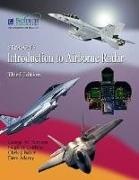Mehr lesen
Greatly expanded from the best-selling second edition by George W.Stimson, this book offers a complete overview of the major developments in air and spaceborne radar in line with advances in modern technology.
Inhaltsverzeichnis
- Part I: Overview of Airborne Radar
- Chapter 1: Basic Concepts
- Chapter 2: Approaches to Implementation
- Chapter 3: Representative Applications
- Part II: Essential Groundwork
- Chapter 4: Radio Waves and Alternating Current Signals
- Chapter 5: A Nonmathematical Approach to Radar
- Chapter 6: Preparatory Math for Radar
- Part III: Fundamentals of Radar
- Chapter 7: Choice of Radio Frequency
- Chapter 8: Directivity and the Antenna Beam
- Chapter 9: Electronically Scanned Array Antennas
- Chapter 10: Electronically Scanned Array Design
- Chapter 11: Pulsed Operation
- Chapter 12: Detection Range
- Chapter 13: The Range Equation: What It Does and Doesn't Tell Us
- Chapter 14: Radar Receivers and Digitization
- Chapter 15: Measuring Range and Resolving in Range
- Chapter 16: Pulse Compression and High-Resolution Radar
- Chapter 17: Frequency-Modulated Continuous Wave Ranging
- Part IV: Pulse Doppler Radar
- Chapter 18: The Doppler Effect
- Chapter 19: The Spectrum of a Pulsed Signal
- Chapter 20: The Pulsed Spectrum Unveiled
- Chapter 21: Doppler Sensing and Digital Filtering
- Chapter 22: Measuring Range-Rate
- Part V: Clutter
- Chapter 23: Sources and Spectra of Ground Return
- Chapter 24: Effect of Range and Doppler Ambiguities on Ground Clutter
- Chapter 25: Representing Clutter
- Chapter 26: Separating Ground Moving Targets from Clutter
- Part VI: Air-to-Air Operation
- Chapter 27: PRF and Ambiguities
- Chapter 28: Low PRF Operation
- Chapter 29: Medium PRF Operation
- Chapter 30: High PRF Operation
- Chapter 31: Automatic Tracking
- Part VII: Imaging Radar
- Chapter 32: Radar and Resolution
- Chapter 33: Imaging Methods
- Chapter 34: SAR Image Formation and Processing
- Chapter 35: SAR System Design
- Part VIII Radar and Electronic Warfare
- Chapter 36: Electronic Warfare Terms and Concepts
- Chapter 37: Electronic Warfare Support
- Chapter 38: Electronic Attack
- Chapter 39: Electronic Protection
- Chapter 40: Decoys
- Chapter 41: Low Probability of Intercept (LPI)
- Part IX: Special Topics and Advanced Concepts
- Chapter 42: Antenna Radar Cross Section Reduction
- Chapter 43: Advanced Processor Architectures
- Chapter 44: Bistatic Radar
- Chapter 45: Distributed Radar and MIMO Radar
- Chapter 46: Radar Waveforms: Advanced Concepts
- Chapter 47: Target Classification
- Chapter 48: Emerging Radar Trends
- Part X: Representative Radar Systems
- Chapter 49: Airborne Early Warning and Control
- Chapter 50: Reconnaissance & Surveillance
- Chapter 51: Space Based Radar Systems
- Chapter 52: Fighter & Attack
Über den Autor / die Autorin
George W. Stimson was the author of
Introduction to Airborne Radar (1st and 2nd editions) and served as an engineer on Southern California Edison's frequency-change project before being hired by Hughes Aircraft Company. Working closely with the company's top designers, Stimson observed first-hand the fascinating evolution of airborne radar and with the help from Hughes engineers updated the first edition with 11 new chapters.
Zusammenfassung
Greatly expanded from the best-selling second edition by George W.Stimson, this book offers a complete overview of the major developments in air and spaceborne radar in line with advances in modern technology.

